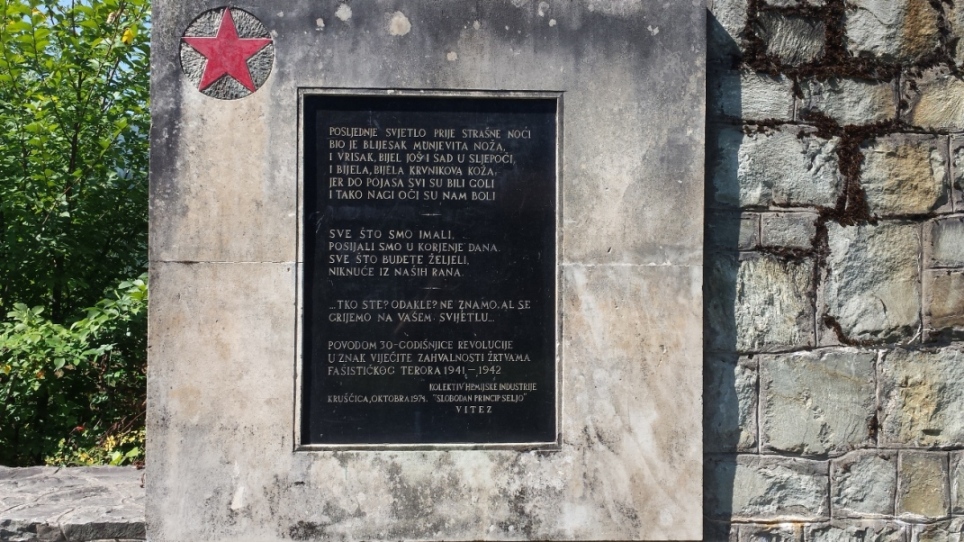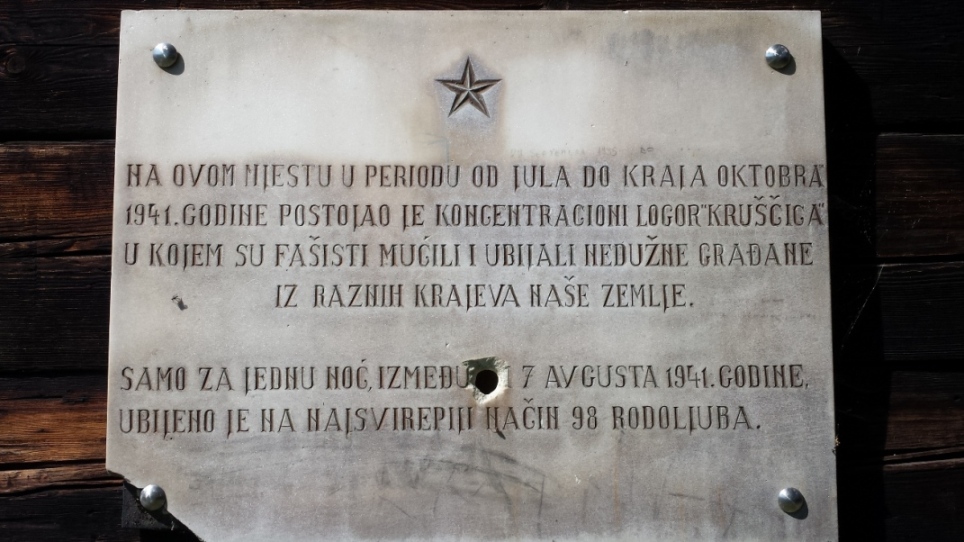|
|
Period:
Second World War
Region:
Bosnia
The Croatian (Ustasha) camp Krušćica in Bosnia 1941
Camp Krušćica was an Ustasha camp in the village of Krušćica, in the vicinity of Vitez in central Bosnia and Herzegovina, that is on the border between Italian and German occupying authorities on the territory of the dismantled Kingdom of Yugoslavia.
This camp existed for only several months, from the end of June until the end of October 1941, and it was one of many Ustasha authorities in the Independent State of Croatia (ISC).
In that Ustaha dungeon, the “ineligible citizens” were brought mostly from areas of the cities of Sarajevo, Zenica, Tuzla…
The number of imprisoned Serbs, Jews, and Roma in this dungeon was around 3,000, while several hundred were killed in monstrous ways with firearms and scold steel, but they were dying from hunger, sickness, cold, as well. Women were often raped in front of their loved ones; Around 1,000 did not survive this torment.
This camp was created after the closure of the system of concentration camps Jadovno-Gospić-Pag at the end of July 1941, where 40,000 Serbs, Jews, and Roma were also killed.
Under the authority of the criminal Vejkoslav “Maks” Luburić, an Ustasha functionary Marian Mijo Babić aka “Djovani” came to the place of Vitez and former a dungeon for torture and eradication of Serbs and Jews.
BACKGROUND
The Kingdom of Serbs, Croats, and Slovenians, the first South Slavic state, later renamed into the Kingdom of Yugoslavia, was created after the First World War, with its promulgation on December 1, 1918, in Belgrade. The territory of the Yugoslav Kingdom was divided into banates in 1929 and the structure of its government was a parliamentary monarchy.

Proclamation of the first South Slavic state
The royal title was held by the Serbian Karadjordjević dynasty. It consisted of Southern Serbia, Šumadija, Raška, Kosovo and Metohija, Eastern Serbia, Montenegro, Bosnia and Herzegovina, Vojvodina, Slavonija, a small part of Dalmatia, the Dubrovnik Republic, Lika, Kordun, Banija, Zagorje, Gorski Kotar, and Slovenia.
After the assassination of King Alexander I Karadjordjević in Marseilles on October 9, 1934, the country was ruled by regents: Prince Paul Karadjordjević, Dr. Radenko Stanković, and Dr. Ivo Perović, and the government was formed by Dragiša Cvetković and Vlatko Maček.

Belgrade's demonstration on March, 1941.
In the mid-1930s, Europe witnessed the rise of Nazism and Fascism, especially in Germany, Italy, and Spain. This led to the formation of the Tripartite Pact, on September 27, 1940, between Germany, Italy, and Japan. In the next months, this alliance was joined by the following countries: Hungary, Bulgaria, Romania, Albania, etc. Thus, the Kingdom of Yugoslavia found itself surrounded by Axis Powers.
In Vienna, on March 25, 1941, the signing of the protocol between the Kingdom of Yugoslavia and Nazi Germany took place regarding the passage of German and Italian troops through Yugoslav territory. Among the patriotic forces of the Kingdom of Yugoslavia, this was interpreted as treason, and the British and Soviet intelligence officers organized a military coup and demonstrations on March 27, 1941 in Belgrade resulting in the overthrow of the governorship led by Prince Paul and putting on the throne a minor king Petar II Karadjordjević.
Hitler changed the plans and the armed forces' plans to attack Greece, were diverted to the Kingdom of Yugoslavia.
ESTABLISHMENT
Marijan Mijo Babić, an Ustasha who returned from emigration, aka Djovani, received an order from his superior Vjekoslav Maks Luburić, who was the commander of all Ustasha camps in ISC, to form a camp in central Bosnia and Herzegovina for Serbs and Jews, which Babić did on 24 of July 1941.
Reasons for establishing this dungeon was the closure of Ustasha’s system of camps Jadovno-Gospić-Pag under the initiative of Italian occupational authorities because they feared a rebellion from the Serbs. After all, many Serbs were killed in these camps.
Krušćica is a place in the municipality of Vitez, only 70km Noth-West of Sarajevo, in central Bosnia in a triad of Travnik-Zenica-Bugojno.
Cottages from World War I were still located in these areas for political prisoners of the Yugoslav monarchical authorities. Ustasha just used this for their morbid plans of eradicating Serbs and other inadequate populations.
CAMP OPERATIONS
Jure Francetić was an Ustasha commissioner for Bosnia and Herzegovina, who employed his deputy Drago Julek to fix the cottages in Krušćica and place the fences around the cam, which is what he did. Hence the first group of inmates arrived from Gospić in cattle wagons over Jastrebar. Then, 75 Serbs were arrested around Sarajevo, mostly around Pal, and coercively brought to Krušćica.
For the commander of the camp, Jozo Gesler was appointed by Maks Luburić personally. The camp itself was guarded by the so-called 13th Ustasha battalion.
The second group of inmates, around 30 of them, arrived from Zenica. They were workers and farmers with a few communist activists.
Commander Gesler ordered an investigation for the arrest and detention of two Croats and one Muslim, and for the execution of this order, Marian Ćilić was appointed. Gessler himself came one night drunk and killed an inmate with a gun. As a bullet lodged in the gun, the inmates started running and were killed by Ustasha guards. Ustasha from Travnik and Vitez received reinforcements. That night around 100 inmates, mostly from Pal were killed. Commander Gesler was badly wounded and died the same night.
Ustashe command appointed Mate Mandušić, who received 60 Ustashas as reinforcements. From September 1941, many Serbs arrived in the camp and even more Jews from areas of Sarajevo and Herzegovina. Hence the number of inmates was over 1,550 people.
A good portion of inmates was thrown into a nearby pit with lime.

CLOSURE
Nikola Tusun, Ustasha commander from Travnik complained to Eugen Dido Kvartenik, the Chief of General Staff of NDH about the problems in the camp, after which Ustasha authorities closed the camp on many occasions. One part of the inmates was transferred to the concentration camp Jasenovac, while the other to camp Logobrad, near the city of Zagreb.
The camp itself in Krušćica ceased its operations on 27 October 1941, but that didn’t mean that the persecution of Serbs and Jews had stopped, on the contrary. This continued, especially in Bosnia.

TESTIMONIES
Bosiljka Radan, a housewife from Stolac (Herzegovina) said the following about the camp:
- “In Krušćica near Travnik, not only did authorities neglect the hygiene but also forbid women to clean their clothes. The cottage was unfinished, the roof leaked above the floor of dirt. Women fed their children with corn stalks, the peelings of potatoes, leaves of pumpkins, and lettuce.
They had to defend themselves from the harassment of Ustashe and would lie on top of their daughters to protect them from rape”.
YEARS LATER
Yugoslav communist authorities put an effort to prevent spreading stories about the atrocities done upon the Serbs because they allegedly endangered the idea of brotherhood and unity – the basis on which second Yugoslavia was built.
After the war, on the location of the former camp, authorities turned one of the cottages into a small memorial museum, and the cottage itself was called: “The Black House”.
The monument that was raised in the mid-1970s has a communist star, even though the majority of the victims were not communists but Serbs of Orthodox faith.
During the war in Bosnia 1992-1995, this monumental compound was destroyed by the Croatian extremists, who wanted to destroy all the evidence of the existence of Serbs in Bosnia and Herzegovina.
Tags:
|
|
|
|
|
|
INDEPENDENT STATE OF CROATIA
|
|
|
|
|
|
|
| | | | | |
Please, vote for this article:
Visited: 3333 point
Number of votes: 5
|